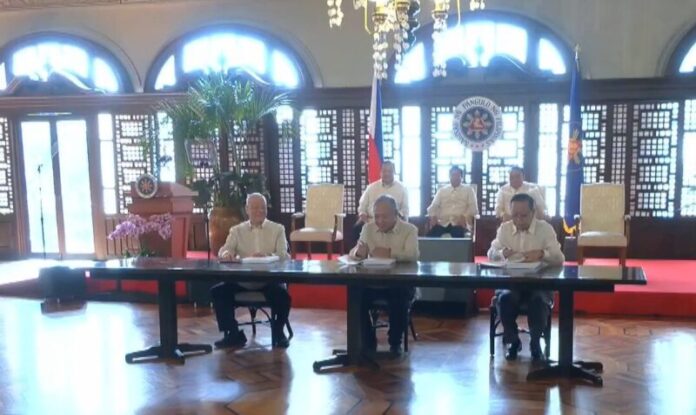
-
The Department of Transportation, Manila International Airport Authority, and SMC SAP & Company Consortium signed today (March 18) the P170.6-billion concession agreement for the Ninoy Aquino International Airport rehabilitation project
-
With the signing, the operations and maintenance of the airport will be handed over to the concessionaire on or before September 2024
-
A special purpose company, New NAIA Infra Corp., was established for the project
The Department of Transportation (DOTr), Manila International Airport Authority (MIAA), and SMC SAP & Company Consortium signed today (March 18) the P170.6-billion concession agreement for the Ninoy Aquino International Airport (NAIA) rehabilitation project.
The agreement signed by Transport Secretary Jaime Bautista, MIAA general manager Eric Jose Ines, and San Miguel Corporation (SMC) president and chief executive officer Ramon Ang signals the start of the modernization of the country’s main gateway.
SMC SAP won the bidding for the project, submitting the highest bid amount and offering to share 82.16% of future gross revenue, excluding passenger service charges, with the government.
READ: SMC-led consortium bags P170.6B NAIA rehabilitation project
It bested two other bidders, GMR Airports Consortium that offered 33.30% and Manila International Airport Consortium with the lowest offer of 25.91%.
SMC SAP consists of San Miguel Holdings Corp., RMM Asian Logistics, Inc.; RLW Aviation Development Inc., and Incheon International Airport Corp.
“We welcome this development for the NAIA PPP (public private partnership) project as this will not only generate revenue for the government but it will also create opportunities for Filipinos. With a modernized NAIA, we are elevating the airport’s facilities and services to international standards,” Bautista said.
“I am sure the New NAIA Infra Corp. has a wide network of financing resources to support their vision for this airport,” he added, referring to the new special purpose company established for the project.
President Ferdinand Marcos Jr., in a speech during the concession signing, urged SMC SAP to fulfill its commitments under the concession.
Marcos said: “This undertaking is not just about revenues that will be remitted to treasury alone, but resources invested in the airport and in many ways. It is an investment in our future.”
He added: “San Miguel Corporation President and CEO Ramon Ang, who promises that he will fix this problem once and for all. And if his record is anything to go by, I’m fairly confident that he will manage to… by hook or by crook gagawin niya’t gagawin niya (he’ll do it).”
Finance Secretary Ralph Recto in a separate statement said the project “sets the benchmark for efficiency for the government’s pipeline projects, being the fastest-approved PPP proposal in Philippine history.”
Bidding for the NAIA rehabilitation project was completed in 12 months, one of the fastest-if not the fastest-for a solicited PPP by the government.
“If we act with the same dispatch on all public projects, I am confident that we can sustain the momentum of growth necessary to deliver an inclusive economy for our people,” Recto said, adding that the project also sets a precedent for future PPP initiatives, guaranteeing the greatest economic returns for all stakeholders.
The 15-year contract involves the rehabilitation, expansion and operation of NAIA to address long standing capacity issues. The project aims to increase NAIA’s annual capacity to at least 62 million passengers from 35 million and enhance air traffic movement from 40 to 48 per hour.
The contract adheres to Republic Act No. 6957, as amended by Republic Act No. 7718 (Build-Operate-and-Transfer Law), and its 2022 revised implementing rules and regulations.
Under a rehabilitate-operate-expand-transfer arrangement, the concessionaire has 15 years–extendable by another 10 years–to enhance airport passenger terminals, airside facilities, develop commercial assets and utility systems, and provide surface access facilities for intermodal transfer, inter-terminal passenger transfer facilities, and services, among other obligations.
New passenger terminal building
Ang said they plan to build a new passenger terminal building (PTB) to be located at the abandoned Philippine Village Hotel with a capacity of 35 million passengers a year and feature 50 passenger boarding bridges.
All offices in the existing terminals of NAIA will be relocated to the new passenger terminal building, Ang said, freeing up space of up to 30% and in the process decongesting Terminals 1, 2, and 3 of the airport.
Bautista said they are optimistic the transition to the new operator will be seamless, with the current employees prioritized. He earlier assured no layoffs will happen as the new concessionaire will prioritize hiring current employees. MIAA employees not involved in operations will continue their roles with the authority, which Bautista said will now focus on its regulatory functions.
Once the concessionaire has taken over operations, the public can expect improvements after a few months or by 2025, Bautista earlier said.
These include shorter and more predictable waiting time at the check-in and immigration counters, availability in parking, improved security checks, availability of seats, time it takes for the baggage to be transferred from the aircraft belly to the conveyor belts, reliable operating escalators and passenger boarding bridges.
The project is expected to generate around P900 billion or P36 billion per year of revenue for the national government in the course of the full 25 years of the concession. This is inclusive of the concessionaire’s P30 billion upfront payment, fixed annuity payment of P2 billion annually, and 82.16% government share.
Capital outlay for the project is estimated at around P88 billion in the first six years, or at least P122.3 billion for the entire 25-year concession period. The estimated capital outlay is non-binding and may increase depending on the requirements.
Ines said there will be an increase in NAIA rates but that it will be minimal. He noted that the last time rates were increased was in April 2000.
A public consultation on the proposed upward adjustment of fees and charges imposed by MIAA on the use of its services, facilities and equipment, the schedule and particulars was held last February 12. – Roumina Pablo




